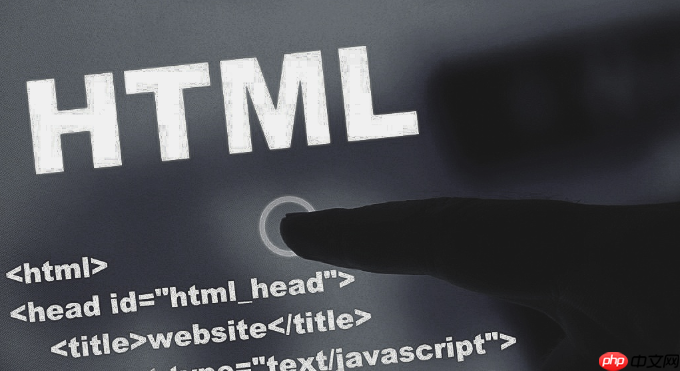答案:HTML中实现折叠面板有两种主要方式,一是使用语义化标签<details>和<summary>,无需JavaScript即可实现基础功能,适合简单场景;二是通过HTML结构、CSS样式与JavaScript交互结合,实现高度自定义的动画与逻辑,适用于复杂需求。前者简单高效但样式控制受限,后者灵活强大但需更多代码。同时需关注无障碍性与性能优化,如使用aria-expanded、懒加载等技术提升用户体验。

HTML中实现折叠面板,说白了,这事儿主要就两种玩法:一种是利用HTML5自带的
<details>
<summary>
<details>
<summary>
这是最简单、语义化最好的方式。你几乎不需要写任何JavaScript代码就能实现一个基础的折叠面板。
<div style="border: 1px solid #ccc; padding: 10px; margin-bottom: 15px; border-radius: 4px;">
<details>
<summary style="font-weight: bold; cursor: pointer; padding: 5px 0;">点击这里展开/收起</summary>
<div style="padding-top: 10px; border-top: 1px dashed #eee; margin-top: 10px;">
<p>这是折叠起来的内容。你可以放文字、图片,甚至其他复杂的HTML结构。</p>
<ul>
<li>列表项一</li>
<li>列表项二</li>
<li>列表项三</li>
</ul>
<p>原生方案的优点是浏览器自带无障碍性,键盘操作也能很好支持。</p>
</div>
</details>
</div>说明:
<details>
<summary>
<summary>
<details>
这种方式虽然代码量稍多,但能让你完全掌控折叠面板的样式、动画和交互逻辑,自由度极高。
立即学习“前端免费学习笔记(深入)”;
HTML 结构: 我们通常会用一个按钮或标题来触发折叠,一个容器来包裹可折叠的内容。
<div style="border: 1px solid #ccc; padding: 10px; margin-bottom: 15px; border-radius: 4px;">
<button class="custom-collapsible-btn" style="background-color: #f1f1f1; color: #444; cursor: pointer; padding: 10px 15px; width: 100%; text-align: left; border: none; outline: none; font-size: 16px; transition: background-color 0.2s;">
点击这里自定义展开/收起
</button>
<div class="custom-collapsible-content" style="max-height: 0; overflow: hidden; transition: max-height 0.3s ease-out, padding 0.3s ease-out; background-color: #f9f9f9; padding: 0 15px;">
<div style="padding: 10px 0;">
<p>这段内容默认是隐藏的,通过点击按钮来控制它的显示与隐藏。这种方式更灵活,可以实现更复杂的动画和样式。</p>
<img src="https://via.placeholder.com/200x80" alt="示例图片" style="max-width: 100%; height: auto; display: block; margin: 10px 0;">
<p>比如,你可以控制展开时的背景色、边框样式,甚至是加载动态内容。</p>
</div>
</div>
</div>CSS 样式: 关键在于
max-height: 0; overflow: hidden;
transition
/* 示例CSS,实际项目中应放在独立的.css文件中 */
.custom-collapsible-content {
max-height: 0; /* 初始隐藏 */
overflow: hidden;
transition: max-height 0.3s ease-out, padding 0.3s ease-out; /* 平滑过渡效果 */
background-color: #f9f9f9;
padding: 0 15px; /* 初始padding为0,展开时再设置 */
}
/* 当内容展开时,添加一个active类 */
.custom-collapsible-content.active {
/* max-height 需要足够大,以容纳所有内容,或者动态计算 */
/* 这里暂时给一个足够大的值,或者用JS动态计算 */
max-height: 500px; /* 假设内容最大高度,需要根据实际情况调整 */
padding: 10px 15px; /* 展开时设置padding */
}
.custom-collapsible-btn.active {
background-color: #ddd; /* 按钮展开时的背景色 */
}JavaScript 逻辑: 监听按钮点击事件,切换内容的
active
max-height
max-height
scrollHeight
// 示例JavaScript,实际项目中应放在独立的.js文件中
document.addEventListener('DOMContentLoaded', () => {
const buttons = document.querySelectorAll('.custom-collapsible-btn');
buttons.forEach(button => {
button.addEventListener('click', function() {
this.classList.toggle('active'); // 切换按钮的激活状态
const content = this.nextElementSibling; // 获取紧随其后的内容容器
if (content.classList.contains('active')) {
// 如果内容是激活状态,展开它
content.style.maxHeight = content.scrollHeight + 'px'; // 设置为实际内容高度
content.style.paddingTop = '10px'; // 展开时设置顶部padding
content.style.paddingBottom = '10px'; // 展开时设置底部padding
} else {
// 如果内容是非激活状态,收起它
content.style.maxHeight = '0';
content.style.paddingTop = '0';
content.style.paddingBottom = '0';
}
content.classList.toggle('active'); // 切换内容的激活状态
});
});
});注意: 上述JS代码中,
content.classList.toggle('active')if
if/else
if/else
classList.contains('active')maxHeight
document.addEventListener('DOMContentLoaded', () => {
const buttons = document.querySelectorAll('.custom-collapsible-btn');
buttons.forEach(button => {
button.addEventListener('click', function() {
const content = this.nextElementSibling; // 获取紧随其后的内容容器
this.classList.toggle('active'); // 切换按钮的激活状态
content.classList.toggle('active'); // 切换内容的激活状态
if (content.classList.contains('active')) {
// 如果内容是激活状态,展开它
content.style.maxHeight = content.scrollHeight + 'px'; // 设置为实际内容高度
content.style.paddingTop = '10px';
content.style.paddingBottom = '10px';
} else {
// 如果内容是非激活状态,收起它
content.style.maxHeight = '0';
// 为了在收起时也平滑过渡padding,可以在这里延迟移除
// 但更简单的方式是让transition同时作用于max-height和padding
// 所以这里直接设置为0即可
content.style.paddingTop = '0';
content.style.paddingBottom = '0';
}
});
});
});这样,当
maxHeight
0
scrollHeight
scrollHeight
0
<details>
<summary>
说实话,当我第一次接触到
<details>
<summary>
但话说回来,它也有它的“脾气”。最让人头疼的可能就是样式控制了。你想改那个默认的小箭头?有点麻烦,得用CSS伪元素或者背景图去覆盖,而且不同浏览器表现可能还有点差异,偶尔还会遇到一些意想不到的兼容性问题。我个人觉得,虽然可以通过
::-webkit-details-marker
list-style: none
很多时候,原生的
<details>
自定义方案的优势在于完全的控制力。你可以设计任何你想要的按钮样式、内容容器样式,甚至可以引入更复杂的CSS动画库(比如Animate.css)来实现各种炫酷的展开/收起效果。我个人在做一些营销活动页或者产品详情页时,就更倾向于自定义方案。它可以与设计稿完美契合,同时还能集成一些额外的逻辑,比如在面板展开时触发一个埋点,或者懒加载面板内部的图片或视频,这些都是原生方案难以提供的。
实现上,关键在于CSS的
max-height
overflow: hidden
transition
max-height: 0
max-height
max-height
scrollHeight
max-height
在做折叠面板时,除了功能和美观,无障碍性(Accessibility,简称A11y)和性能也是我特别关注的两个点。一个好的折叠面板不应该只对鼠标用户友好,对键盘用户、屏幕阅读器用户也同样重要。
对于无障碍性,如果你用的是原生的
<details>
summary
role="button"
aria-expanded
aria-controls
aria-expanded
true
false
aria-controls
至于性能优化,这主要体现在自定义实现上。
transition
animation
height
opacity
offsetHeight
max-height
overflow: hidden
src
scrollHeight
debounce
throttle
总之,无论是选择原生方案还是自定义方案,理解它们的优缺点,并兼顾无障碍性和性能,才能真正构建出用户体验良好的折叠面板。
以上就是HTML中如何实现折叠面板的详细内容,更多请关注php中文网其它相关文章!

HTML怎么学习?HTML怎么入门?HTML在哪学?HTML怎么学才快?不用担心,这里为大家提供了HTML速学教程(入门课程),有需要的小伙伴保存下载就能学习啦!

Copyright 2014-2025 https://www.php.cn/ All Rights Reserved | php.cn | 湘ICP备2023035733号